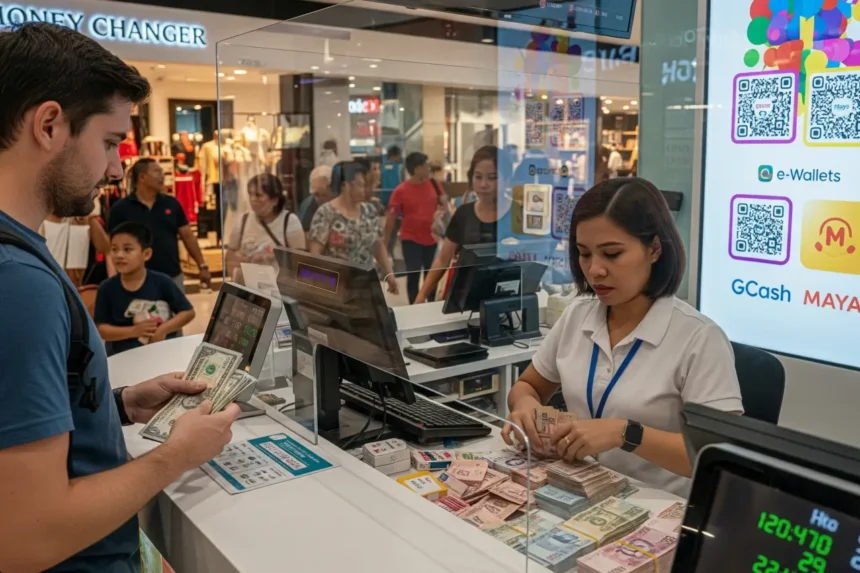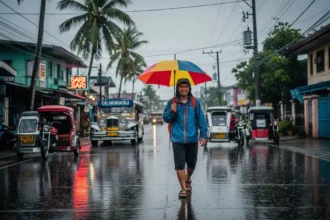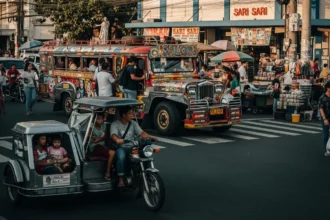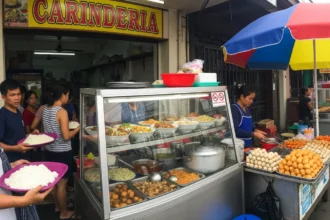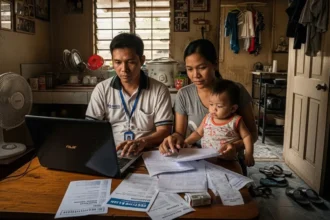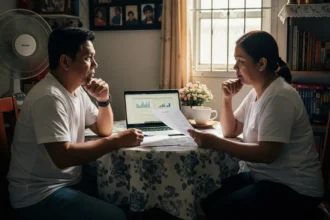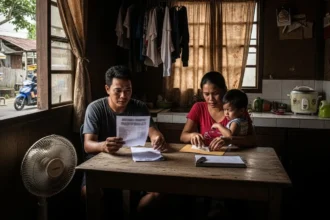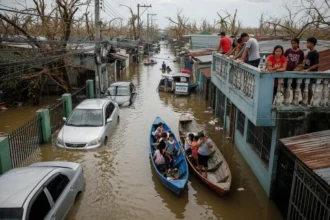They say “Cash is King” – and in the Philippines, that’s still true in 2025. Whether you’re buying street food, hopping on a jeepney, or shopping in a provincial market, cash often rules where cards and apps don’t. But at the same time, the country is embracing ATMs, digital wallets like GCash, and credit card payments more than ever.
- 💵 Why Cash Is Still King in the Philippines
- 🏧 Using ATMs in the Philippines
- 💱 Money Changers in the Philippines
- 💳 Paying with Credit and Debit Cards
- 📱 Digital Payments in 2025: GCash, Maya, and Beyond
- 🧾 Typical Costs & Fees to Expect (2025 Snapshot)
- 🔐 Safety Tips for Handling Money in the Philippines
- 🌍 Special Notes for Tourists and Balikbayans
- 📚 Glossary of Money Terms in the Philippines
- 📝 Quick Reference Tables
- ❓ FAQs
- 🌟 Smart Money Habits in the Philippines
For tourists, balikbayans, and even locals moving around the islands, figuring out the best way to withdraw, exchange, and spend money can be confusing. Which ATMs charge the lowest fees? Where can you find the most reliable money changers? When should you use GCash or swipe your card instead of paying in cash?
This guide answers all those questions. By the end, you’ll know exactly how to handle money in the Philippines wisely, safely, and with diskarte – so you can enjoy your trip or daily life without stressing over payments.
💵 Why Cash Is Still King in the Philippines
Despite the rise of digital wallets and credit cards, cash remains the backbone of everyday life in the Philippines. Here’s why:
Daily Transactions Still Depend on Cash
-
Public transport: Jeepneys, tricycles, buses, and even provincial ferries almost always require exact fare in coins and bills.
-
Small businesses: Sari-sari stores, carinderias, wet markets, and street vendors are overwhelmingly cash-only.
-
Service tips: Whether it’s giving a tip to a parking boy or buying snacks from a street vendor, coins and small bills make life easier.
Trust & Accessibility
-
Many Filipinos still trust physical money more than digital balances, especially in rural towns where internet and mobile signal can be spotty.
-
ATMs and money changers are present even in second-tier cities, while digital wallet acceptance can be hit-or-miss.
Inflation & Spending Habits
-
With rising prices, people often budget day-to-day in cash envelopes (sobre system) – a traditional way of managing expenses.
-
For many households, handling money physically helps control spending better than swiping a card.
The Bottom Line
Cash may not be as convenient as tapping your phone, but it’s still the most reliable and widely accepted payment method in the Philippines. Tourists and balikbayans especially need to carry enough peso bills and coins to get through everyday activities smoothly.
💡 Diskarte Tip: Always keep a mix of small denominations (₱20, ₱50, ₱100) for daily spending. Larger bills (₱500, ₱1000) can be hard to break in jeepneys, tricycles, or smaller shops.

🏧 Using ATMs in the Philippines
ATMs are the easiest way to get Philippine pesos, whether you’re a tourist withdrawing foreign funds or a local managing daily cash. But there are quirks – from withdrawal limits to surprising fees – that you should know before you insert your card.
Where to Find ATMs
-
Airports: Almost every international and domestic terminal has ATMs, though they often charge the highest fees.
-
Malls & Banks: The safest and most reliable options. SM, Ayala, and Robinsons malls have multiple ATMs from different banks.
-
Convenience Stores: 7-Eleven, Ministop, and some gas stations have standalone ATMs – useful but usually with lower withdrawal limits.
💡 Diskarte Tip: Always look for ATMs inside malls or bank branches. They’re safer and less prone to card skimming.
Supported Networks
-
Most ATMs accept Visa, Mastercard, Cirrus, and Plus.
-
Some also accept UnionPay and JCB, especially in tourist-heavy areas.
-
Look for stickers/logos on the machine before inserting your card.
Withdrawal Limits (2025)
-
Local cards: usually ₱10,000–₱20,000 per withdrawal.
-
Foreign cards: some ATMs cap at ₱10,000 per transaction.
-
Multiple withdrawals are allowed, but you’ll pay the fee each time.
ATM Fees (2025 Snapshot)
-
Local withdrawal fees: ₱10–₱18 per transaction (for local cardholders).
-
Foreign withdrawal fees: ₱250–₱300+ per withdrawal, depending on the bank.
-
Some foreign banks also add their own charges on top.
💡 Always check the on-screen confirmation – fees are displayed before you finalize the withdrawal.
Tips to Avoid Issues
-
Withdraw during daytime for safety.
-
Cover your hand when entering your PIN.
-
If the ATM eats your card, immediately report it to the bank branch (if attached).
-
Keep a backup card in case your primary gets blocked.
-
Don’t rely on finding ATMs in remote towns – stock up on cash before heading provincial.
💡 Diskarte Reminder: While ATMs are convenient, the fees can pile up. Many balikbayans and tourists prefer bringing USD or EUR and changing them at money changers instead (we’ll cover this in the next section).
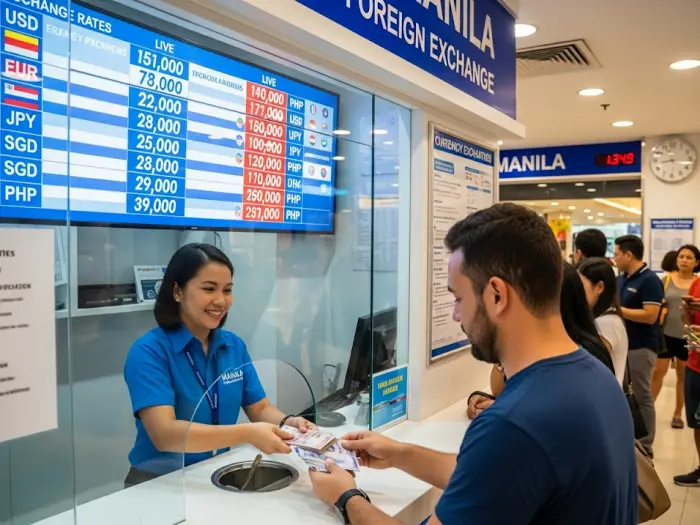
💱 Money Changers in the Philippines
While ATMs are convenient, many balikbayans and tourists prefer using money changers to stretch their budget. The rates are usually better than withdrawing pesos abroad, but not all changers are equal – some are legit, others are risky.
Where to Find Money Changers
-
Airports: Always available, but with lower exchange rates. Great for convenience, not for large amounts.
-
Malls: Reliable and safe. Chains like Sanry’s, Czarina, and Villarica are popular choices inside big malls.
-
City Centers: In Makati, Manila, and Cebu, you’ll find clusters of money changers with competitive rates.
-
Hotels & Resorts: Convenient but often offer poor rates compared to malls or city shops.
💡 Diskarte Tip: For first-time arrivals, exchange just a small amount at the airport for transport and food. Save the bulk exchange for a mall money changer.
How to Spot Reliable Money Changers
-
Licenses & Receipts: Legit money changers are usually accredited by the BSP (Bangko Sentral ng Pilipinas). Always ask for a receipt.
-
Transparent Rates: Posted clearly on a digital board or printed sheet. Avoid shops that hesitate to show rates upfront.
-
Professional Setup: A booth inside a mall or a proper office is safer than an informal stall on the street.
Typical Rates vs. Airport Rates (2025 Snapshot)
-
Airport: ₱55 per USD (convenient, but weakest rate).
-
Mall/City Changer: ₱56.50–₱57 per USD (better and safer).
-
Street/Informal: ₱57+ but risky – possibility of fake bills or scams.
Safety Tips When Exchanging Money
-
Count your money before leaving the counter.
-
Don’t carry huge wads of cash in public; split your money into smaller amounts.
-
Exchange only what you need if traveling outside big cities (ATMs and changers may be rare).
-
Never exchange with random individuals who approach you on the street, no matter how tempting the rate.
💡 Diskarte Reminder: Think of airport changers as your “starter pack.” For better value, do the real exchange in trusted malls or city centers.
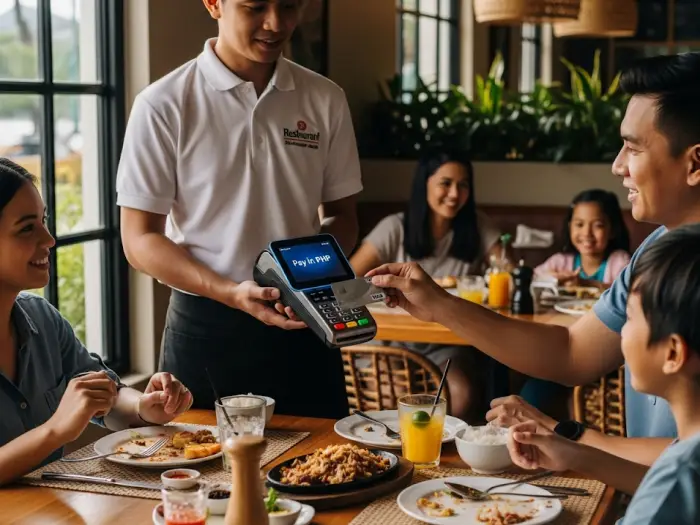
💳 Paying with Credit and Debit Cards
Cards are widely accepted in the Philippines – but not everywhere. While malls and hotels will happily swipe your Visa or Mastercard, many everyday transactions are still strictly cash-only. Here’s what you need to know before relying on plastic.
Where Cards Are Accepted
-
Malls & Supermarkets: Almost all large retail stores (SM, Robinsons, Ayala) accept debit and credit cards.
-
Hotels & Resorts: Standard payment option for bookings, check-ins, and restaurants inside.
-
Chain Restaurants & Coffee Shops: Starbucks, Jollibee, McDonald’s, and other large franchises usually take cards.
-
Big-Box Stores: Furniture shops, appliance centers, and department stores accept them.
Where Cards Are Rarely Accepted
-
Public Transport: Jeepneys, tricycles, buses, ferries – always cash.
-
Wet Markets & Carinderias: Small vendors typically won’t take cards.
-
Sari-Sari Stores & Street Food Stalls: Strictly cash, usually small bills only.
-
Provincial Towns: Card acceptance outside cities is limited, sometimes only at the mall.
💡 Diskarte Tip: Use cards for large purchases (₱500+), but always keep cash for day-to-day spending.
Fees & Conversions
-
Dynamic Currency Conversion (DCC): Some shops ask if you want to pay in USD/EUR instead of PHP. Always choose PHP to avoid hidden conversion fees.
-
Surcharges: Some stores quietly add a 2–3% fee for credit card use, especially in smaller shops. Ask before swiping.
-
Foreign Transaction Fees: Your home bank may also charge 1–3% for overseas transactions.
Best Practices for Card Payments
-
Carry at least one Visa and one Mastercard, since acceptance can differ.
-
Decline DCC (always pay in pesos).
-
Use cards mainly for hotels, shopping, and dining in big establishments.
-
Don’t rely on cards when traveling to rural areas.
💡 Pro Reminder: Credit and debit cards are convenient, but the Philippines is still a cash-first economy. Treat cards as your backup for big-ticket purchases, not as your main daily wallet.
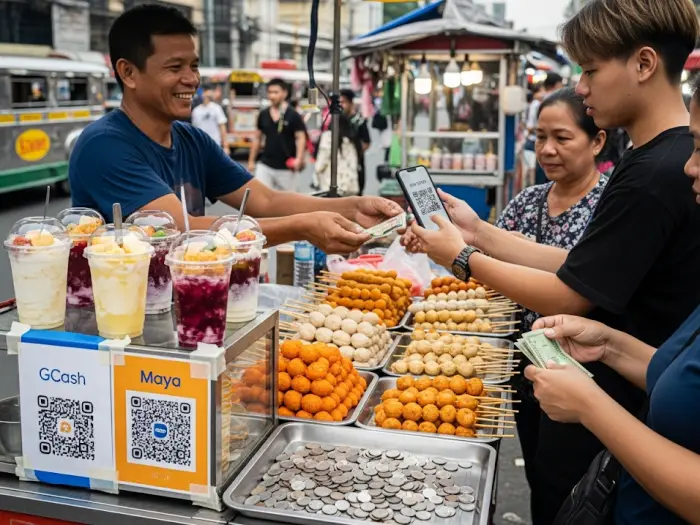
📱 Digital Payments in 2025: GCash, Maya, and Beyond
The Philippines is catching up fast with cashless payments. In 2025, digital wallets like GCash and Maya are everywhere, from fast-food chains to small sari-sari stores. But while adoption is growing, cash is still the default in many places – especially outside major cities.
GCash: The Leader in E-Wallets
-
Where It’s Accepted: Convenience stores, taxis, ride-hailing apps, Lazada/Shopee, and even some market vendors with QR codes.
-
How to Use It: Link your SIM, load at 7-Eleven, pawnshops, or bank transfer.
-
Tourists/Balikbayans: Some foreign SIM users may face registration limits, but you can buy a local prepaid SIM and sign up in minutes.
💡 Diskarte Tip: If you’re staying long-term, grab a local SIM and activate GCash – it makes paying bills and shopping seamless.
Maya & Other Wallets
-
Maya (formerly PayMaya): Growing rapidly, especially in malls and online shops.
-
ShopeePay & LazPay: Mostly for e-commerce transactions but slowly expanding to physical shops.
-
GrabPay: Useful for rides and GrabFood, but less common outside Metro Manila.
Limitations of Digital Payments
-
Provincial Gap: In rural towns, GCash is accepted only in select stores. Many tricycles, sari-sari shops, and palengkes are still cash-only.
-
Internet Dependency: Spotty signal in provinces means QR scans sometimes fail.
-
Cash-Out Fees: Transferring money from wallets to banks (or vice versa) often has fees of ₱15–₱20.
The 2025 Reality Check
-
In Metro Manila, Cebu, and Davao, you can often get by with just GCash + a card.
-
But in the provinces, cash still rules – especially for transport, markets, and small businesses.
💡 Pro Reminder: Think of e-wallets as supplements to cash, not replacements. Carry both, and you’ll be ready anywhere.
🧾 Typical Costs & Fees to Expect (2025 Snapshot)
Managing money in the Philippines isn’t just about where to withdraw or exchange – it’s also about knowing the hidden costs and fees that can add up if you’re not careful. Here’s what you should expect in 2025.
ATM Withdrawal Fees
-
Local ATM cardholders: ₱10–₱18 per transaction (standard bank charge).
-
Foreign cards: ₱250–₱300+ per withdrawal, plus possible extra fees from your home bank.
-
Multiple withdrawals: Some ATMs cap at ₱10,000–₱20,000 per transaction, so bigger cash-outs mean multiple fees.
💡 Diskarte Tip: If you’re a tourist, it’s often cheaper to exchange a larger amount at a money changer than to keep withdrawing from ATMs.
Money Changer Spreads
-
Airport rates: Often 1–1.5 pesos weaker than mall/city rates.
-
Mall/city changers: Give the best balance of safety + rates.
-
Street changers: May offer better numbers, but the risk of counterfeit bills is higher.
Credit & Debit Card Fees
-
Merchant surcharge: Some shops add 2–3% for card payments.
-
DCC (Dynamic Currency Conversion): Avoid paying in USD/EUR when asked – always choose pesos to dodge extra conversion costs.
-
Foreign transaction fees: Your home bank may add 1–3% per swipe.
E-Wallet Fees (GCash, Maya, etc.)
-
Cash-in: Often free via linked bank, but some outlets charge ₱10–₱20 per reload.
-
Cash-out to banks: ₱15–₱20 per transfer, unless promo-free.
-
QR Payments: Usually free for consumers, but sometimes vendors add ₱1–₱5 for small transactions.
Quick Table: Money Costs in 2025
| Transaction Type | Typical Fee / Spread | Notes |
|---|---|---|
| Local ATM withdrawal | ₱10 – ₱18 | For local bank cards |
| Foreign ATM withdrawal | ₱250 – ₱300+ | Plus possible home bank charges |
| Airport money changer | ~₱55/USD | Convenient but lowest rate |
| Mall/city money changer | ~₱56.50–₱57/USD | Best balance of safety & rates |
| Card surcharge | 2–3% | Some merchants add this |
| GCash/Maya bank transfer | ₱15 – ₱20 | Unless waived during promos |
💡 Pro Reminder: Don’t panic if you see fees – they’re part of the system. What matters is knowing where to minimize costs (e.g., mall money changers > airport counters, card in pesos > card in USD).
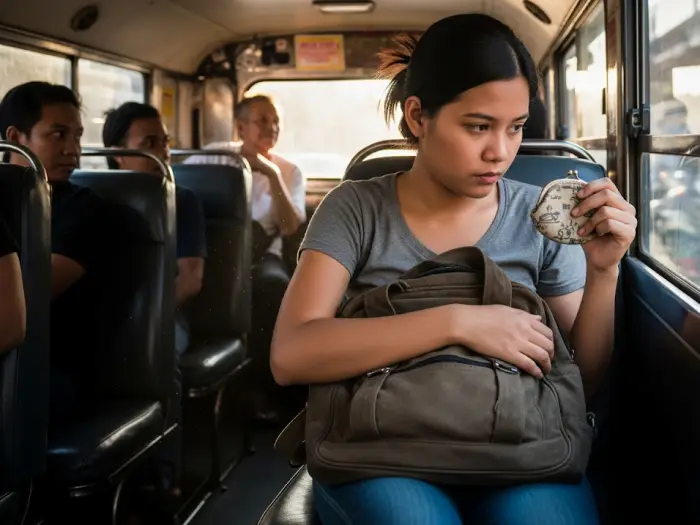
🔐 Safety Tips for Handling Money in the Philippines
Carrying money in the Philippines is generally safe, but like anywhere else, you need to stay alert – especially in crowded areas and tourist spots. Here’s how to protect your cash and cards in 2025.
Don’t Carry All Your Cash at Once
-
Keep only what you’ll need for the day.
-
Leave backup cash in your hotel safe or at home.
-
Split your money between your wallet, a pocket, and a secure pouch.
Use Discreet Storage
-
Money belt or sling bag: Ideal for tourists in busy areas.
-
Front pockets: Safer than back pockets for wallets and phones.
-
Small coin purse: Keeps fares and small bills handy without flashing big cash.
Be Smart at ATMs
-
Use ATMs inside banks or malls, not isolated ones on the street.
-
Cover your PIN when entering it.
-
Don’t accept help from strangers if a machine “malfunctions.”
-
Withdraw during daytime if possible.
Watch Out in Crowded Spots
-
Jeepneys, buses, and public markets are prime places for pickpockets.
-
Hold your bag in front of you in tight crowds.
-
Don’t count large bills in public – do it discreetly or wait until you’re in private.
Card & E-Wallet Security
-
Set SMS/email alerts for every transaction.
-
Don’t hand your card to waiters without keeping it in sight (skimming can happen).
-
Lock your e-wallet app with biometrics or PIN.
-
Avoid using public Wi-Fi for online banking or wallet reloads.
💡 Diskarte Tip: Think “layered security.” Carry only what you need, stash the rest, and stay alert in busy places. Most Filipinos commute daily with cash on hand – you’ll be fine if you follow basic precautions.
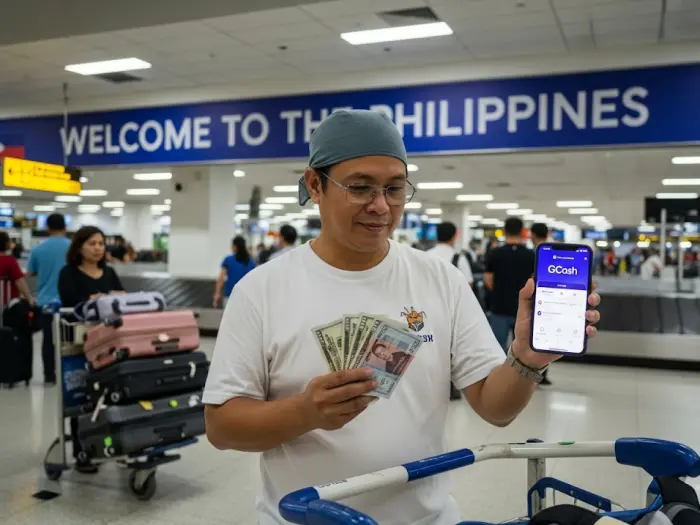
🌍 Special Notes for Tourists and Balikbayans
If you’re visiting the Philippines for the first time or coming home after years abroad, handling money here can feel different from what you’re used to. These tips are especially for you.
Bring a Mix of Cash and Cards
-
Cash for daily spending: Jeepneys, tricycles, carinderias, and sari-sari stores don’t accept cards.
-
Cards for big purchases: Hotels, malls, and restaurants are safer places to swipe or tap.
-
USD and EUR are best: They’re the easiest currencies to exchange at money changers.
💡 Diskarte Tip: Don’t bring only big bills (like $100s or €100s). Smaller denominations are useful in case a money changer can’t break large notes.
Don’t Rely on Hotels or Airports for Exchange
-
Hotels are convenient but give poor exchange rates.
-
Airports are okay for small starter amounts but not for exchanging bulk cash.
-
For the best value, head to mall-based or city-center money changers.
Plan Ahead for Provinces
-
ATMs in rural towns are fewer and may run out of cash on weekends or holidays.
-
Bring enough cash before traveling to the provinces.
-
Not all provincial areas have money changers – and if they do, rates may be weaker.
Backups for Emergencies
-
Western Union, Palawan Express, Cebuana Lhuillier: Popular remittance centers where you can send/receive money quickly.
-
GCash for tourists: If you get a local SIM, load up GCash for QR payments in stores and restaurants.
-
Multiple cards: Carry at least two bank cards in case one gets blocked by your bank for “suspicious activity.”
💡 Pro Reminder: Tourists and balikbayans often underestimate how cash-based daily life still is in the Philippines. Treat cash as your “survival tool,” and use cards and wallets as convenient extras.
📚 Glossary of Money Terms in the Philippines
If you’re new to the Philippines, you’ll quickly notice that Filipinos mix English with local terms when talking about money. Here’s a handy glossary to keep you in the loop:
-
Barya – Coins or small change. Example: “Wala akong barya, ₱500 lang ang dala ko.”
-
Sukli – Change given back after paying. Example: “Pakisukli po sa ₱100.”
-
Padala – Money remittance, often through centers like Palawan Express or Western Union. Example: “Magpapadala ako sa probinsya.”
-
Remittance Center – Shops like Palawan Express, Cebuana Lhuillier, or Western Union where people send and receive money locally or internationally.
-
Sobre System – The envelope method of budgeting, where cash is divided into envelopes by category (food, rent, savings).
-
GCash Load – Adding money to your GCash wallet, usually done at convenience stores, pawnshops, or banks.
-
Boundary – A fixed daily amount drivers (jeepney, taxi, tricycle) must give to the vehicle owner before keeping the rest as earnings.
-
Paluwagan – A community savings scheme where members contribute regularly, and each member takes turns receiving the lump sum.
-
ATM Balance Inquiry Fee – Some banks charge ₱2–₱3 even just to check your balance.
-
Over-the-Counter Fee – Extra charge (₱10–₱30) when paying bills or sending padala in person instead of online.
💡 Diskarte Reminder: Learning these terms not only helps you understand daily money conversations but also makes you sound more like a local.
📝 Quick Reference Tables
These tables give you a fast overview of what to expect when handling money in the Philippines in 2025.
1. ATM Fees (Local vs. Foreign, 2025)
| ATM Type | Typical Fee | Withdrawal Limit per Transaction | Notes |
|---|---|---|---|
| Local bank card | ₱10 – ₱18 | ₱10,000 – ₱20,000 | Most common fee for Filipinos |
| Foreign debit/credit card | ₱250 – ₱300+ | ₱10,000 – ₱20,000 | Plus possible home bank fee |
| Balance inquiry (some ATMs) | ₱2 – ₱3 | N/A | Charged even without withdrawal |
2. Sample Exchange Rate Differences (2025)
| Location | Example Rate (USD → PHP) | Notes |
|---|---|---|
| Airport counter | ~₱55 / USD | Lowest, best only for small starter cash |
| Mall changer | ~₱56.50 – ₱57 / USD | Best balance of rate + safety |
| Street changer | ₱57+ / USD (risky) | Possible fake bills, unsafe |
3. Card & E-Wallet Acceptance Overview
| Payment Method | Where Widely Accepted | Where Rarely Accepted |
|---|---|---|
| Credit/Debit | Malls, hotels, supermarkets, chains | Jeepneys, tricycles, wet markets, sari-sari stores |
| GCash | Convenience stores, taxis, QR shops | Many provincial towns, small vendors without signal |
| Maya | Malls, online shops | Rural markets, transport |
| GrabPay | Grab rides, GrabFood | Outside Metro Manila |
| Cash | Universally accepted everywhere | N/A |
💡 Diskarte Tip: Use this as a cheat sheet – carry cash for transport and small buys, cards for malls and hotels, and GCash for quick QR payments in the city.
-
Western Union – Philippines currency guide: The Philippine peso (PHP)
-
Fintech News Philippines – How GCash is Evolving to be a Global Fintech Powerhouse
❓ FAQs
1. Can I use my foreign debit card in Philippine ATMs?
Yes, most ATMs accept Visa, Mastercard, Cirrus, and Plus. Just check the stickers on the machine. Expect ₱250–₱300 per withdrawal plus possible home bank charges.
2. How much is the ATM withdrawal fee for foreigners in 2025?
Typically ₱250–₱300 per withdrawal, depending on the bank. Some ATMs may add limits (₱10,000 per transaction), so multiple withdrawals = multiple fees.
3. What’s better – changing money at the airport or in the city?
Airport changers are convenient but offer weaker rates. Exchange only a starter amount there, then go to mall or city money changers for better value.
4. Are US dollars widely accepted in the Philippines?
Not for daily purchases. Hotels may accept USD, but jeepneys, stores, and markets only take pesos. Always convert to local currency.
5. Is it safe to use my credit card everywhere?
Safer in malls, hotels, and chain stores. Avoid handing your card over in small shops or unknown establishments. Always pay in pesos to skip hidden DCC fees.
6. Can tourists use GCash or Maya?
Yes, if you register a local SIM and set up the app. Many foreigners buy prepaid SIMs at the airport and use GCash for QR payments in the city.
7. How much cash should I carry daily in the Philippines?
₱1,000–₱2,000 is enough for food, transport, and small shopping. Carry more only if you’ll be in rural areas with no ATMs.
8. Are ₱1000 bills commonly accepted, or should I break them?
Big stores and malls accept them, but jeepneys, tricycles, and sari-sari stores will struggle. Always break ₱1000 bills at supermarkets or banks.
9. Do taxis and tricycles accept digital payments now?
Some taxis in Metro Manila accept GCash or Maya, but most tricycles are still cash-only. Always keep coins and small bills ready.
10. What’s the safest way to carry money while traveling around?
Split your money: keep some in your wallet, some in a hidden pouch, and a backup in your hotel. Don’t carry all your cash at once.
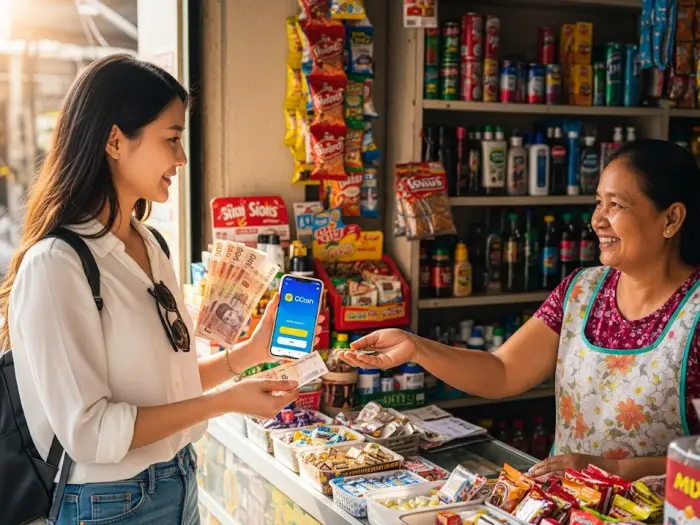
🌟 Smart Money Habits in the Philippines
In 2025, the Philippines is a mix of old and new when it comes to payments. You’ll see QR codes taped to sari-sari store counters, but you’ll also need coins to pay for a tricycle ride. You can swipe your card at an Ayala mall, but you’ll still hand over a crumpled ₱20 at a carinderia for lunch.
The truth is, cash is still king, but the smart commuter, traveler, or balikbayan knows how to balance all three: cash for everyday life, cards for bigger expenses, and e-wallets for quick convenience.
Carry small bills for transport and street food. Keep a card ready for malls, restaurants, and hotels. And load up GCash or Maya to skip long lines and enjoy cashless perks. With a little preparation and diskarte, you won’t just save on fees – you’ll also blend in smoothly with how Filipinos really live and pay.
At the end of the day, managing money here isn’t just about avoiding extra costs – it’s about finding the sulit way to enjoy your stay, whether you’re here for a week, a year, or a lifetime.



